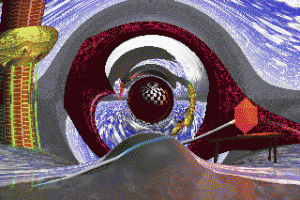Spacetime and Black Holes (Physics 264)
Sean Carroll
Fall quarter, 2005

(simulation of image distortion by a black hole, from Werner Benger’s raytracing page)
Description
This course offers an introduction to general relativity, Einstein’s theory of gravitation, particularly as applied to black holes. After a review of special relativity and a discussion of the notion of four-dimensional spacetime, the basic tools of physics in a curved spacetime will be introduced (especially the metric tensor characterizing distances in spacetime, the generalization of partial derivatives to covariant derivatives, and the geodesic equation governing the motion of free particles). The Schwarzschild solution describing both black holes and the exteriors of stars and planets will be presented, and the behavior of objects in a Schwarzschild spacetime will be extensively studied. The course will conclude by introducing further mathematical tools (the Riemann tensor) and the dynamical equations relating energy/momentum to spacetime curvature (Einstein’s equations).
Prerequisites
In University-speak, the requirements are Physics 185 and either Math 204 or Math 221, or permission of the instructor. You should be familiar with basic mechanics, matrices, and partial differential equations, as well as special relativity. As everyone knows, general relativity involves a good deal of mathematics, especially differential geometry and tensor calculus. We will develop these tools as we go along, so no prior experience is necessary; more important will be a willingness to assimilate new concepts and notations and quickly put them to use (what is sometimes called “mathematical maturity”). Ambitious second-year students should be able to take the course, with the understanding that we will be introducing a substantial set of unfamiliar ideas.
Grading
The final grade will be based 60% on problem sets and 40% on a take-home final exam. You are encouraged to talk to your fellow students about the problem sets, but make sure that what you hand in is produced by you.
Dates and Times
The course will meet on Tuesdays and Thursdays, 12:00-1:20 p.m., in Kersten 105. There will also be a weekly recitation session led by the TA, Wednesdays at 5:30-6:30.
Personnel
Sean Carroll, Professor
Ishai Ben-Dov, Teaching Assistant
Outline
- Introduction (Hartle chapters 1-3)
- Special Relativity and Flat Spacetime (4-5)
- Curvature of Spacetime (6-7)
- Physics in Curved Spacetime (8)
- The Schwarzschild Solution (9)
- Black Holes (12-13)
- Einstein’s Equation and Further Topics (20-22)
Problem Sets
Problem sets will be handed out on Thursdays, due the following Thursday. Sets are posted here in pdf.
- Problem Set One, due Oct 6.
- Problem Set Two, due Oct 13.
- Problem Set Three, due Oct 20.
- Problem Set Four, due Oct 27.
- Problem Set Five, due Nov 3.
- Problem Set Six, due Nov 10.
- Problem Set Seven, due Nov 17.
Books
Click on the titles to see the amazon.com entry for each book. You can even buy them online if you like.
- J.B. Hartle, Gravity: An Introduction to Einstein’s General Relativity (Addison-Wesley, 2002).
Required. A new book, well-done and with the same approach as the present course. Interesting spacetime metrics, such as the Schwarzschild solution relevant in the solar system and black holes, are first explored, and only later derived as solutions to Einstein’s equation. - B.F. Schutz, A First Course in General Relativity (Cambridge, 1985).
This is an excellent book, pretty much at the level of the present course. The organization follows the traditional approach for graduate courses, first discussing the curvature tensor and Einstein’s equation before actually solving for specific spacetimes; our approach will be inside-out. - S.M. Carroll, Spacetime and Geometry: An Introduction to General Relativity (Addison-Wesley, 2003).
My own book. I like it, but it’s more advanced than the present course. Could still be a useful reference.
Other Resources
- My Lecture Notes on General Relativity from a graduate course taught at MIT in 1996. This course will be shorter and oriented towards undergraduates, but the notes are still going to be a very useful reference. This page also has links to further resources.
- To get right to the heart of the matter, here is A No-Nonsense Introduction to General Relativity in pdf.
- Here is a list of GR books and other resources.